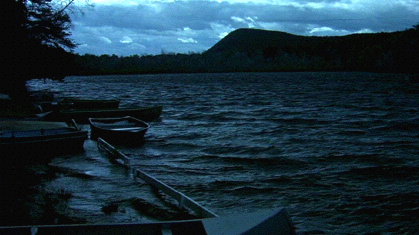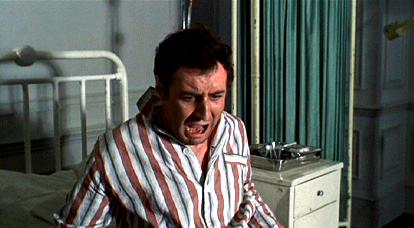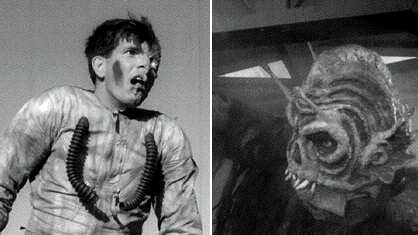Director: Al Adamson
Writers: William Pugsley, Samuel M. Sherman
Producers: Al Adamson, Samuel M. Sherman, John Van Horne
Cast: J. Carrol Naish, Lon Chaney, Jr., Regina Carrol, Anthony Eisley, Anne Morrell, Greydon Clark, Zandor Vorkov (Roger Engel), John Bloom, Jim Davis, Russ Tamblyn, Maria Lease, Angelo Rossitto, Shelly Weiss, Forrest J. Ackerman, William Bonner
Las Vegas entertainer Judith Fontaine (Regina Carrol) heads to Venice, California looking for her missing sister Joan (Maria Lease). She runs into hippies, bikers, and Dr. Durea, the proprietor of a spook show exhibit at the beachside carnival. Dr. Durea (J. Carrol Naish) had his brutish henchman Groton (Lon Chaney, Jr.) kill Joan and others to use their bodies for strange blood experiments. Durea is actually the last of the Frankenstein family that created a man-made monster. That monster has been exhumed and brought to Dr. Durea by Count Dracula (Zandor Vorkov). Dracula wants Durea to revive the monster and to continue his blood experimentation that will grant Dracula even greater power.
The Flashback Fanatic movie review
Dracula vs. Frankenstein is the most well known of director Al Adamson’s films. This is due primarily to the famous monster duo in the title, not to any cinematic merit. It is a seriously compromised project because of its constant reinvention to try to turn the original attempt called The Blood Seekers into a commercially successful exploitation product. I have always wondered how The Blood Seekers, as originally completed, would have played. It had to be more cohesive than what Dracula vs. Frankenstein became.
The kid in me can still get off on the offbeat elements in the film: mad science, monsters, violence, and sexy women. The whole exploitative and schlocky vibe of this thing keeps drawing me back to it. Yet with all of that tantalizing stuff jammed haphazardly into it, I also see this film as a big missed opportunity.
As producer and co-writer Samuel M. Sherman has explained in interviews and the DVD audio commentary, the Dracula and Frankenstein characters were not part of the original film. They were added in with additional rewrites and new film footage thinking it would make the movie more commercial. Knowing that production history, one can almost marvel at the audacity of trying to reconfigure an already finished film to such an extent. The original storyline may have been exploitation fodder, but all the added Dracula and Frankenstein stuff give the impression that the whole film seems like it is being improvised.
The two horror genre veterans, J. Carrol Naish and Lon Chaney, Jr., give their last film performances in Dracula vs. Frankenstein. One can only assume that the original The Blood Seekers film would have been a better showcase for them, if it were more coherent. Perhaps scenes were cut that gave the Naish and Chaney characters more depth or motivation.
As it stands now, the audience is expected to accept a lot based on horror movie character tropes; Dr. Durea is a mad scientist and Groton is his simple-minded henchman. The point of Durea’s blood experimentation is vague. Groton’s need for injections that transform him into a pasty-faced killer, and then are used to also calm his spontaneous transformations, is a Jekyll-and-Hyde movie gimmick. Although I love tried-and-true movie gimmicks, I just wish there was a little better setup for these characters and their motives.
Much of Naish’s dialogue is of that roundabout drivel that is supposed to sound lofty and intelligent in low-budget schlock. Chaney has no dialogue, as he is once again reduced to the mute menace role. Unfortunately, this was a necessity because of the throat cancer that he was suffering from at the time.
Regina Carrol is a voluptuous attraction in many Al Adamson films, as she was also his wife. Her cleavage always steals the scene. The routine we see her perform in her first scene, as Judith Fontaine, was part of Regina’s act when she actually did perform in Las Vegas.
Anthony Eisley as Mike is just about the most atypical hero in any horror movie. He comes across like a slick establishment type that decided to stop parting his hair and throw on some love beads over his turtleneck pullover and live on the beach. He seems like a nice enough guy until he makes his free love move on Judith. I can’t say I blame him, but that “We don’t want to get involved, do we? Just be good friends” line before he starts tongue wrestling with her always struck me as wonderfully sleazy. Lounge lizard or hippie wannabe, it’s still all about the old in-and-out.
Russ Tamblyn emits that don’t-give-a-damn vibe as Rico, the lead troublemaker in a trio of bikers. This character was almost a reprise of his biker character Anchor from an earlier Adamson/Sherman production Satan’s Sadists (1969). Unfortunately, his Rico role was edited down from The Blood Seekers version of the film to make room for the new Dracula/Frankenstein footage. With seemingly no effort and little screen time, Tamblyn’s Rico still manages to be despicable, especially when menacing the lovely hippie Samantha (Anne Morrell).
Then we have the two title characters that keep us from ever being able to appreciate the pure cinematic splendor that could have been The Blood Seekers. Zandor Vorkov’s Dracula has been roundly condemned as the worst Dracula in movie history. With his often inane rambling dialogue that always has a spooky echo, his plastic joke shop fangs, and pasty white make-up that becomes so heavy in the final scenes that he looks like a mime, Vorkov’s Dracula probably makes the film’s most lasting impression for all the wrong reasons. The Frankenstein monster is little more than a prop in this movie. The design of the face is pretty interesting and, with 7’4” John Bloom in the role, this monster has impressive height. But the monster is shoehorned into the movie along with Dracula, and they only interact with three of the main characters; that is the three actors (Naish, Carrol, and Eisley) that would return from The Blood Seekers to shoot additional scenes.
With the budget limitations, the rewriting, the reshooting, and the re-editing, it was impossible that Dracula vs. Frankenstein would turn into a good film. An appreciation of schlock is necessary to derive any enjoyment out of it. I also derive an added interest by knowing its history of reconfiguration. It takes real nerve to graft seemingly unrelated pieces of narrative together into a film in the hopes of improving it. Everything about Dracula vs. Frankenstein has a slapdash feel to it, but I’ll be damned if I don’t look forward to watching it again.























































